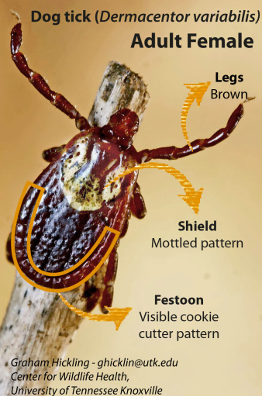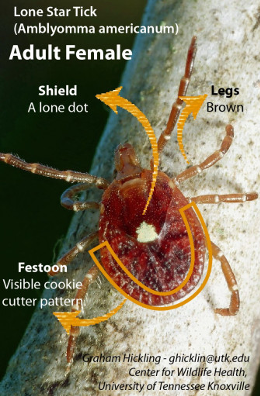Preventing tick bites and detecting invasive ticks: A citizen science study
Ticks are expanding across Michigan, but you can help prevent tick-borne diseases.

Have you ever enjoyed a walk in the woods only to have that experience spoiled hours later when you find a tick embedded in you? Do you want to know what are the best ways to prevent this highly unpleasant and scary situation? Researchers at Michigan State University, University of Wisconsin – Madison, and Columbia University have developed The Tick App - a mobile application that provides proven options for preventing tick bites – all at your fingertips. By using the app, you can help researchers learn what options people are most likely to use. The data will then be used to develop better strategies to motivate people to adopt effective methods and thereby reduce tick bites and tick-borne diseases.
 Ticks are blood-feeding arthropods more closely related to spiders than insects. There are several tick species in Michigan, but three species are responsible for greater than 95% of human tick bites. The American dog tick, often called wood tick, is the most common human-biting tick in Michigan and the vector of Rocky Mountain Spotted Fever, which occurs rarely in Michigan. Michigan State University Extension offers a closer look at this species. The second most common biter is the blacklegged tick, or deer tick, and is the vector for Lyme disease, human anaplasmosis, and several other diseases that are less common. The blacklegged tick has been emerging across Michigan for three decades and the number of cases of Lyme disease been increasing, with risk varying across the state. Depending on where one lives, some residents are very familiar with the tick, whereas some may have never heard about it. Finally, the lone star tick, an aggressive tick native to the southern U.S., occasionally pops up in Michigan but has not yet gotten a firm foothold. With abundant populations now established in northwest Indiana, however, lone star ticks are poised to spill over and invade our state. Unfortunately, all three species actively feed on companion animals as well.
Ticks are blood-feeding arthropods more closely related to spiders than insects. There are several tick species in Michigan, but three species are responsible for greater than 95% of human tick bites. The American dog tick, often called wood tick, is the most common human-biting tick in Michigan and the vector of Rocky Mountain Spotted Fever, which occurs rarely in Michigan. Michigan State University Extension offers a closer look at this species. The second most common biter is the blacklegged tick, or deer tick, and is the vector for Lyme disease, human anaplasmosis, and several other diseases that are less common. The blacklegged tick has been emerging across Michigan for three decades and the number of cases of Lyme disease been increasing, with risk varying across the state. Depending on where one lives, some residents are very familiar with the tick, whereas some may have never heard about it. Finally, the lone star tick, an aggressive tick native to the southern U.S., occasionally pops up in Michigan but has not yet gotten a firm foothold. With abundant populations now established in northwest Indiana, however, lone star ticks are poised to spill over and invade our state. Unfortunately, all three species actively feed on companion animals as well.
Currently, there are no vaccines for any of the diseases vectored by these ticks and there are limited options for reducing ticks in the environment. The best way to prevent diseases is to prevent tick bites in the first place. Tick prevention methods also can be found in The Tick App, along with information about how to identify the different kinds of ticks and the diseases they transmit.
 Researchers need your help to figure out why some people seem to pick up fewer ticks than others in order to develop better strategies for preventing tick bites and tick-borne disease. Furthermore, you might help identify emerging tick populations, which can result in improved prevention, diagnosis, and treatment of disease.
Researchers need your help to figure out why some people seem to pick up fewer ticks than others in order to develop better strategies for preventing tick bites and tick-borne disease. Furthermore, you might help identify emerging tick populations, which can result in improved prevention, diagnosis, and treatment of disease.
Are you ready to be a citizen scientist?
- Begin by downloading the mobile application by searching “The Tick App” in the Google Play or App Store. The Tick App is compatible with a variety of devices. You also have the option to join online through your web-browser (thetickapp.org/ web-app/).
- Provide consent to the research and complete an entry survey that takes 5 to 10 minutes to gather information about your environment as it relates to ticks.
- Begin your daily log and complete 15 logs during the peak tick season (June through early July). The daily log should take about a minute to complete. It asks if you or a household member encountered a tick and what you did that day. When you start your logs during the peak tick period you can get daily reminders, so you remember to check for ticks and to tell the researchers about your outdoor activities.
- Complete tick reports by logging any tick encounters and share information about where the tick was found, on whom it was found, and what kind of tick you think it is. And, if you submit a picture, experts will respond to you by email with probable tick identification.
- Lastly, if you allow location services, the app will use your location to provide you with current information on blacklegged tick activity in your area. Furthermore, location services will help researchers understand how time spent in different areas is associated with tick exposure.
Questions about The Tick App can be directed to the UW-Madison Research team in the Midwest Center of Excellence for Vector-Borne Diseases through tickapp@wisc.edu or 608-265-4741.



 Print
Print Email
Email




